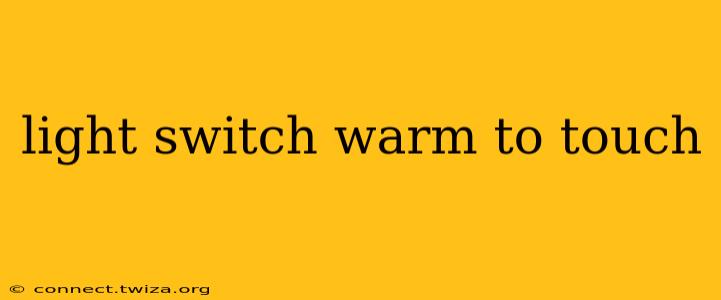A warm light switch is more than just a mildly concerning anomaly; it's a potential indicator of a serious electrical problem. Ignoring it could lead to fire hazards and other safety risks. This guide will explore the common reasons why your light switch feels warm, how to identify the severity of the issue, and the steps you should take to address it.
Why is My Light Switch Warm?
Several factors can cause a light switch to feel warm to the touch. Understanding the underlying cause is crucial in determining the appropriate course of action. Some causes are relatively harmless, while others demand immediate attention from a qualified electrician.
Loose Wiring Connections
One of the most common culprits is loose wiring connections within the switch box. When wires aren't securely connected, the electrical resistance increases, leading to heat generation. This is often accompanied by a buzzing or crackling sound. Loose connections are a fire hazard and should be addressed immediately.
High Current Draw
A light switch might feel warm if it's controlling a circuit with a high current draw. This could be due to multiple high-wattage appliances or lights operating on the same circuit. The switch acts as a bottleneck for this current, causing it to heat up. While not as immediately dangerous as loose wiring, consistently high heat generation over time can still damage the switch and present a risk.
Faulty Light Switch
The light switch itself might be defective. Internal components can malfunction, leading to increased resistance and heat buildup. This is particularly true for older switches that have been subjected to years of use. A faulty switch is a potential fire hazard and should be replaced.
Overloaded Circuit
This is a serious issue. If your circuit is overloaded (too many appliances running simultaneously), it can cause significant heat buildup throughout the entire circuit, including the light switch. Overloaded circuits are a major fire hazard and require immediate attention from a qualified electrician. This often involves adding additional circuits to distribute the load.
Arc Fault
An arc fault occurs when an electrical arc forms within the switch. This can be caused by loose wiring, damaged components, or other issues. Arc faults generate significant heat and are a major fire hazard. They often smell like burning plastic or ozone.
How Serious is a Warm Light Switch?
The severity depends on several factors:
- Temperature: A slightly warm switch is less concerning than one that is hot to the touch.
- Duration: A switch that's only warm for a short period might be less of a concern than one that remains consistently warm.
- Accompanying sounds: Buzzing, crackling, or popping sounds often indicate a more serious problem.
- Smell: A burning smell is a clear indication of a significant electrical problem.
If your light switch is hot to the touch, smells burnt, or makes unusual noises, turn off the circuit breaker immediately and contact a qualified electrician. Do not attempt to troubleshoot the problem yourself.
What Should I Do If My Light Switch is Warm?
Your course of action depends on the severity of the issue:
- Slightly warm: Monitor the situation. If the warmth persists or increases, take further action.
- Moderately warm: Turn off the circuit breaker and inspect the switch for loose wiring. If you're comfortable doing so (and have experience with electrical work), you can tighten any loose connections. If you're unsure, call an electrician.
- Hot to the touch, buzzing, crackling, or burning smell: Turn off the circuit breaker immediately. Do not touch the switch. Call a qualified electrician as soon as possible. This is a serious fire hazard.
Can a Warm Light Switch Cause a Fire?
Yes, a warm light switch can indeed cause a fire. Loose connections, overloaded circuits, faulty switches, and arc faults all generate heat that can ignite surrounding materials. The risk is significantly higher with switches that are hot to the touch, accompanied by unusual sounds or smells.
What are the signs of a bad light switch?
Signs of a bad light switch include a warm or hot switch to the touch, flickering lights controlled by the switch, the switch not turning the lights on or off reliably, burning smells emanating from the switch, and sparking or arcing visible within the switch. These issues often indicate a need for replacement.
This information is for general guidance only and does not substitute professional electrical advice. Always prioritize safety and consult a qualified electrician if you suspect a problem with your electrical system.
